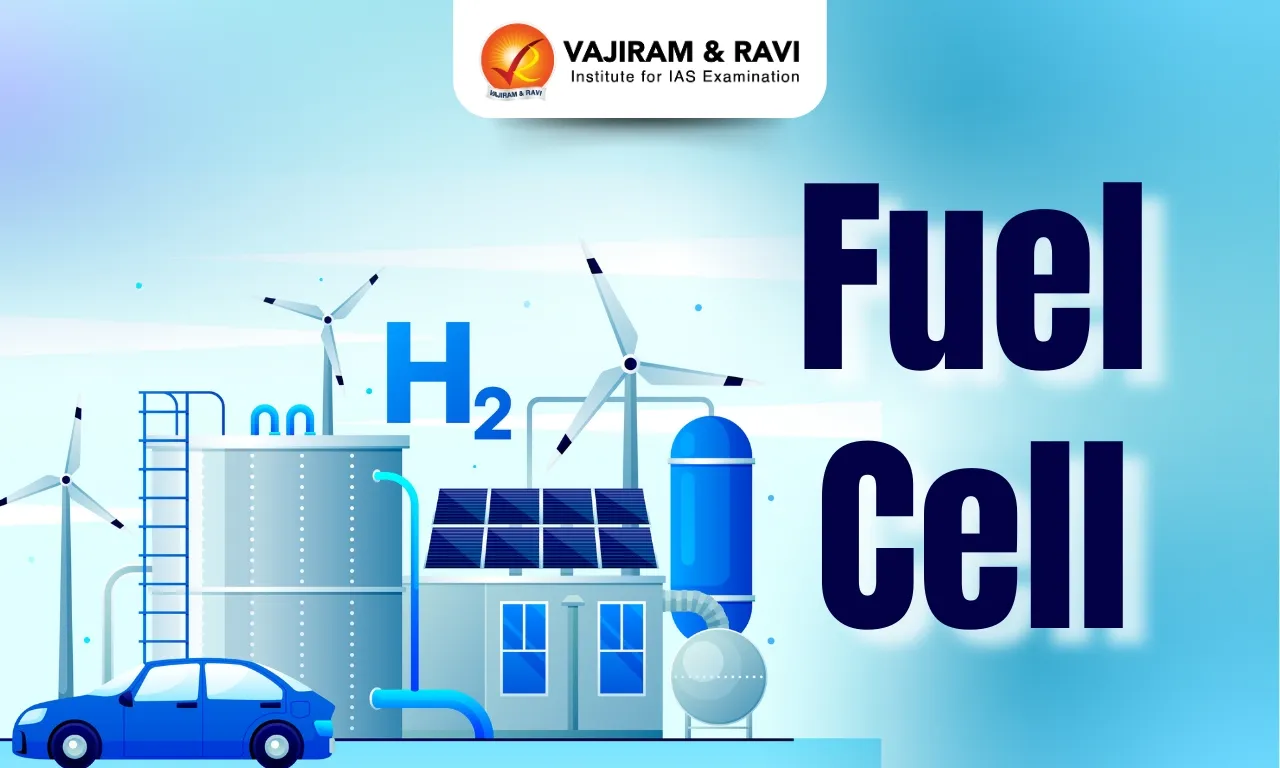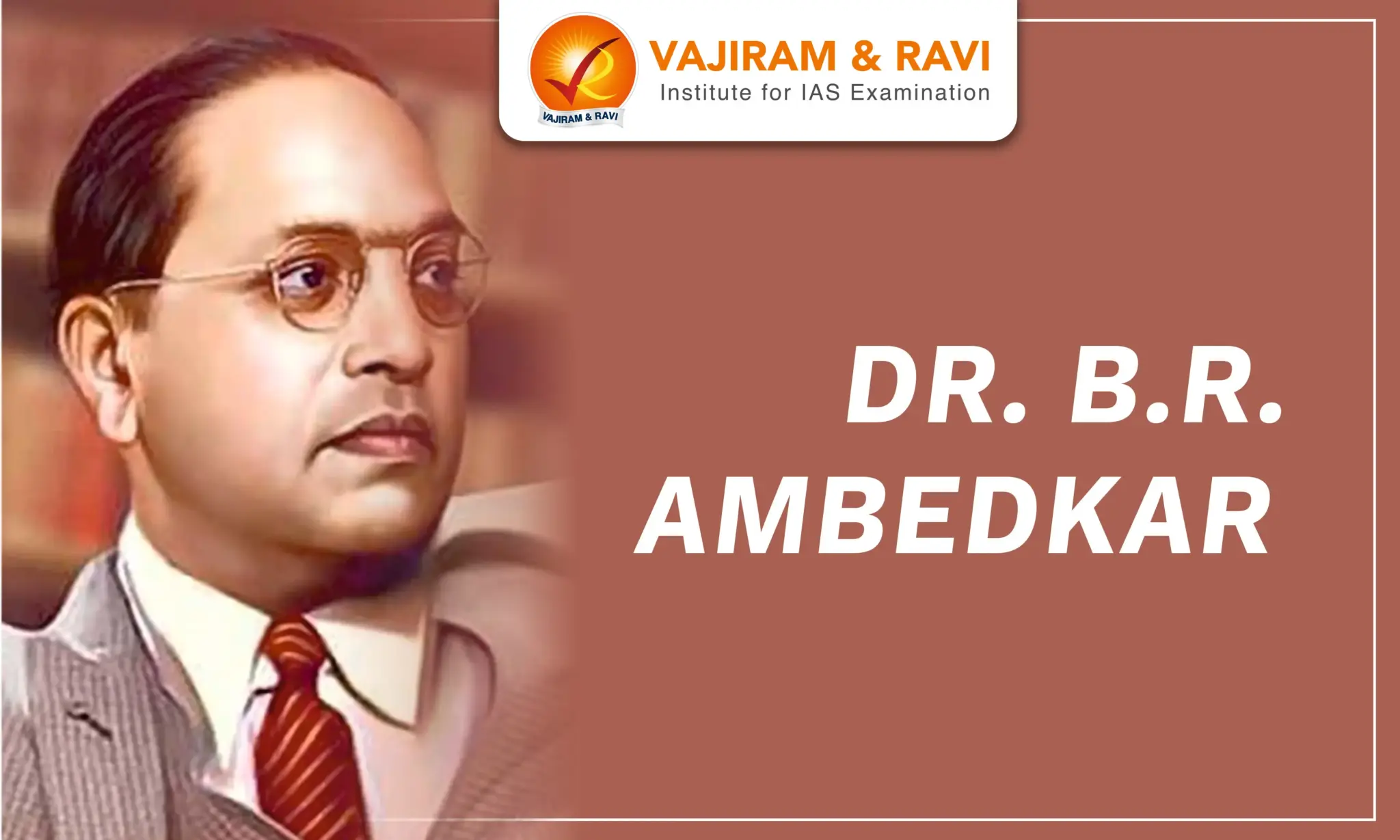Fuel cells are electrochemical devices that generate electricity directly from a fuel, making them highly efficient and pollution-free. Unlike combustion-based power or batteries, fuel cells involve no combustion or recharging. With India's clean energy commitments under the Paris Agreement, the development of alternative power sources like fuel cells is crucial.
Fuel cells can potentially meet 7% of India's power needs by 2032, as per government estimates. Their clean, efficient, and reliable power generation makes fuel cells an important technology for India to explore as it transitions towards sustainable energy. The adoption of fuel cells can significantly cut emissions while ensuring energy security.
About Fuel Cells
Fuel cells are electrochemical devices that produce electricity through a chemical reaction between a fuel (on the anode side) and an oxidant (on the cathode side), with the reaction products being water, electricity, and heat.
Hydrogen is the most commonly used fuel, called Hydrogen fuel cells. Other fuels are methanol, ethanol, natural gas, gasoline etc. Oxygen or air is most commonly used as the oxidant.
How do Fuel Cells work?
Fuel cells consist of an electrolyte layer sandwiched between two electrodes - the fuel electrode (anode) and the oxygen electrode (cathode).
- Key components:
- Anode - Made from porous carbon/metal, it oxidizes the fuel facilitating the release of electrons.
- Cathode - Made from porous carbon/metal, it enables oxidant reduction.
- Electrolyte - Allows only proton transfer between electrodes while blocking electrons.
- Catalyst - Typically platinum; speeds up the oxidation and reduction reactions.
- Fuel - Hydrogen, methanol etc. It is oxidized at the anode.
- Oxidant - Oxygen or air; facilitates reduction reactions at the cathode.
- The fuel (hydrogen, methanol etc.) is fed continuously to the fuel electrode where a catalyst helps it split into protons and electrons.
- The protons pass through the electrolyte to the oxygen electrode while the electrons travel in an external circuit creating electricity.
- At the oxygen electrode, the electrons combine with protons and oxygen to produce water and a little heat.
- This electrochemical reaction generates electricity without any combustion and very low emissions.
- The type of electrolyte decides the operating temperature of a fuel cell. The anode reaction, cathode reaction and overall cell reaction differ based on the fuel and oxidant used. However, the basic working principle remains the same for all fuel cell types.
Types of Fuel Cells
Based on the types of electrolytes used, fuel cells are classified into several types.
- Proton Exchange Membrane Fuel Cell (PEMFC): Uses a water-based acidic polymer membrane as the electrolyte and porous carbon electrodes containing a platinum catalyst. It uses hydrogen as fuel and oxygen/air as oxidant.
- PEMFCs operate at 50-100°C and are compact, lightweight and suitable for transport applications.
- Alkaline Fuel Cell (AFC): Also known as Bacon fuel cell, uses an alkaline solution like potassium hydroxide as the electrolyte and operates at 60-250°C.
- It is one of the most developed fuel cell technologies but is sensitive to CO2.
- Phosphoric Acid Fuel Cell (PAFC): Uses liquid phosphoric acid as the electrolyte and porous carbon electrodes with a platinum catalyst.
- It operates at 150-210°C. PAFCs tolerate a carbon monoxide concentration of about 1.5%.
- Molten Carbonate Fuel Cell (MCFC): Uses a combination of molten carbonate salts as the electrolyte and operates at 600-700°C.
- It can use different hydrocarbon fuels and is suitable for large stationary power applications.
- Solid Oxide Fuel Cell (SOFC): Employs a hard, non-porous ceramic compound as the electrolyte and operates at 500-1000°C.
- SOFCs offer high efficiency and can utilize a variety of fuels. However, high temperatures are a challenge.
Benefits of Fuel Cell Usage
Some of the major benefits offered by fuel cell technology are:
- Clean and efficient energy:
- Fuel cells can electrochemically convert the chemical energy in fuels directly to electricity with very low pollution.
- Unlike combustion engines, no burning takes place in fuel cells. So, emissions like particulate matter (PM), NOx, and SOx are negligible.
- Fuel cells also have much higher efficiency than internal combustion engines.
- Reliable backup power:
- Fuel cells are a clean and silent source of backup power. They offer a highly reliable and uninterrupted power supply compared to diesel generators.
- This makes them suitable for critical facilities like hospitals, data centers, etc. They also have lower maintenance needs than diesel generator sets.
- Energy storage capabilities:
- The combination of fuel cells and electrolysers enables both power generation and energy storage.
- Excess renewable energy can be used to generate hydrogen via electrolysis which can be stored and later fed to fuel cells to generate electricity on demand. Thus, fuel cells can overcome the intermittency issues of renewable energy.
- Fuel flexibility:
- Different types of fuel cells can utilize not just hydrogen but also other fuels like natural gas, biogas, methanol, ethanol depending on the electrolyte used. This provides flexibility in fuel choice.
Challenges for Fuel Cells to be Adopted in India
While fuel cells hold tremendous potential, certain challenges need addressing for their extensive adoption in India:
- High initial costs:
- Fuel cells currently have very high initial capital costs compared to existing power technologies. This is because most components, like electrolytes, catalysts etc are still in the early phases of commercialization.
- Most fuel cell components are imported, which increases costs. Establishing local manufacturing can help reduce costs in the long run.
- Regular maintenance of fuel cell stacks and replacement of catalysts, membranes, and other components add to the operating costs.
- Requires Hydrogen infrastructure:
- A hydrogen refueling infrastructure needs to be established for the widespread use of fuel cell vehicles.
- It requires production, storage, and distribution networks for hydrogen across the country. Currently, hydrogen availability is limited to pockets.
- Technology limitations:
- Technical challenges exist such as improving the durability and lifetime of fuel cell materials and components.
- Water management and thermal efficiency also need improvement for effective fuel cell system operation.
Key Applications of Fuel Cells
Some key applications where fuel cell technology can make a significant impact include:
- Potential for electric mobility:
- Fuel cell electric vehicles (FCEVs) powered by hydrogen offer a promising zero-emission transportation solution. They have higher efficiency and faster refueling compared to battery electric vehicles.
- FCEVs combine hydrogen and oxygen in a fuel cell stack to power the electric motor. Many automakers like Toyota, Hyundai and Honda already have FCEV models.
- With more hydrogen fueling stations, FCEVs can replace fossil-fuel-powered transport.
- Stationary power backup:
- Fuel cells can provide clean and reliable backup power to offices, hospitals, telecom towers, etc.
- Large multi-MW fuel cellsusing natural gas or biogas can also meet baseload power needs.
- Fuel cell-based backup systems offer benefits over diesel generators like reduced emissions, noiseless operation and higher reliability.
- Portable power:
- Small fuel cell systems can power a wide range of portable electronic devices like smartphones, laptops, cameras, etc.
- Microfuel cells on the watt-to-kilowatt scale based on methanol, hydrogen, and sodium borohydride fuels are well-suited for remote or mobile applications.
- With technological advances, portable fuel cells can displace batteries as primary energy sources for many handheld gadgets.
- Off-grid power source:
- Fuel cell systems are well-suited for off-grid power needs in remote areas without access to the central grid.
- Small hydrogen-based PEMFCs can provide off-grid power ranging from watts to kilowatts scale.
- They can overcome the intermittency issues of solar PV systems. Renewable fuels like biogas can also be used with fuel cells for off-grid power.
- Fuel cells can be integrated into combined heat and power (CHP) systems that produce both electricity and usable heat, improving overall efficiency. The waste heat can be utilized for heating or cooling purposes.
Some Real-World Examples of Fuel Cells
- Ballard fuel cell modules power trucks, buses, and trams in Europe and the US.
- Small methanol fuel cells charge mobiles and laptops during natural disasters when grid power is disrupted.
- A 1.4 MW phosphoric acid fuel cell system powered by biogas provides electricity and thermal energy to the ONGC Energy Center in Uran, Maharashtra.
- Indian Railways is testing fuel cell-battery hybrid systems to power coaches and reduce diesel consumption.
- Kerala Startup Mission has deployed micro-PEMfuel cell systems that provide power for telecom towers and weather stations in remote areas.
- DRDO is developing portable methanol-based fuel cells to charge military batteries and equipment in the field.
Government Initiatives and Policies for Fuel Cell
The Government of India has recognized the importance of fuel cell technology and taken initiatives like:
- Launching the National Hydrogen Energy Mission in 2021 to enable cost-competitive green hydrogen production.
- Announcing a National Hydrogen Energy Road Map in 2022 to scale up hydrogen infrastructure.
- Allowing viability gap funding up to Rs. 500 crores for setting up hydrogen hubs and FCEV stations.
- Including FCEVs eligible for demand incentives under the FAME India scheme.
- Setting up R&D facilities like the National Hydrogen Energy Board and Centre of Excellence to develop cost-optimized fuel cells.
- Allowing viability gap funding for fuel cell bus procurement under the FAME scheme.
- Providing subsidies and tax exemptions for local manufacturing of fuel cell components.
- Permitting liberalized green hydrogen/ammonia imports until indigenous production scales up.
- With further policy support, public awareness, and R&D advances, fuel cell technology can potentially transform India's energy landscape.
Last updated on November, 2025
→ Check out the latest UPSC Syllabus 2026 here.
→ Join Vajiram & Ravi’s Interview Guidance Programme for expert help to crack your final UPSC stage.
→ UPSC Mains Result 2025 is now out.
→ UPSC Notification 2026 is scheduled to be released on January 14, 2026.
→ UPSC Calendar 2026 is released on 15th May, 2025.
→ The UPSC Vacancy 2025 were released 1129, out of which 979 were for UPSC CSE and remaining 150 are for UPSC IFoS.
→ UPSC Prelims 2026 will be conducted on 24th May, 2026 & UPSC Mains 2026 will be conducted on 21st August 2026.
→ The UPSC Selection Process is of 3 stages-Prelims, Mains and Interview.
→ UPSC Result 2024 is released with latest UPSC Marksheet 2024. Check Now!
→ UPSC Prelims Result 2025 is out now for the CSE held on 25 May 2025.
→ UPSC Toppers List 2024 is released now. Shakti Dubey is UPSC AIR 1 2024 Topper.
→ UPSC Prelims Question Paper 2025 and Unofficial Prelims Answer Key 2025 are available now.
→ UPSC Mains Question Paper 2025 is out for Essay, GS 1, 2, 3 & GS 4.
→ UPSC Mains Indian Language Question Paper 2025 is now out.
→ UPSC Mains Optional Question Paper 2025 is now out.
→ Also check Best IAS Coaching in Delhi
Fuel Cell FAQs
Q1. What are fuel cells?+
Q2. How are fuel cells different from batteries?+
Q3. Which ministry is responsible for fuel cell development in India?+
Q4. What are the advantages of fuel cells?+
Q5. How can fuel cell adoption be promoted in India?How can fuel cell adoption be promoted in India?+























